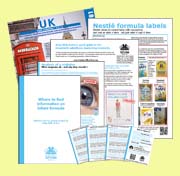Review of the UK law - wrong question, wrong answer
The UK Government appointed an Independent Review Panel to investigate the effectiveness of the formula marketing regulations that came into force at the beginning of 2008. After working for a year, commissioning research and requesting submissions, which Baby Milk Action and others supplied, the Panel published its draft report at the end of September. This concludes that the law does not need to be changed on the grounds mothers are not mistakenly feeding follow-on formula to babies instead of infant formula.
“What has that to do with the effectiveness of the regulations?” some may well ask. The purpose of the Infant Formula and Follow-on Formula Regulations, according to the Guidance Notes that accompany them, is to: “regulate labelling and restrict advertising and presentation of infant and follow-on formula so as not to discourage breastfeeding.”
The Panel was asked: “whether the new controls were fulfilling their objective or whether further action was needed, and if so, what future action may be appropriate.” We expected the panel to investigate if and how formula is being promoted through the internet, point-of-sale promotion, baby clubs, carelines, labels, health claims, advertising of follow-on formula and other marketing practices and whether these undermine breastfeeding and endanger babies fed on formula. We were assured that the investigation would be broad, and similar assurances were made in Parliament.
 The panel also requested an update of our Hard Sell Formula briefing paper outlining company marketing strategies and asked enforcement authorities for their views (see below). The report notes - but does not respond to - the examples provided. Instead it focuses on the mis-feeding of follow-on formula, although these products are now almost the same as infant formulas. The Panel is still working on the report and is due to submit it to the new Public Health Minister, Gillian Merron, in the New Year.
The panel also requested an update of our Hard Sell Formula briefing paper outlining company marketing strategies and asked enforcement authorities for their views (see below). The report notes - but does not respond to - the examples provided. Instead it focuses on the mis-feeding of follow-on formula, although these products are now almost the same as infant formulas. The Panel is still working on the report and is due to submit it to the new Public Health Minister, Gillian Merron, in the New Year.
Panel ignores views of those who have to enforce the Regulations
The draft report quotes the enforcement authorities, but then ignores the issues raised. For example:
LACORS said that they support the view that the same advertising, marketing and promotional controls that apply to infant formula should apply to follow-on formula. These extended controls should be framed so as to cover generic manufacturer names, logos and other pictorial devices in the same manner as those which currently apply to specific individual product names or logos where the likelihood of consumer readacross will occur.
In summary the ASA [Advertising Standards Authority] stated that common complaints about follow-on formula advertisements are that: they indirectly promote the use of infant formula; build general brand awareness and loyalty; denigrate breast feeding; exaggerate and distort the health and nutritional benefits of formula products.
LACORS was specifically asked “Are the 2007 Regulations clear and does this have an impact your ability to take action?” The draft report does not respond to the concerns raised, which include:
Certain websites contain information which would be prohibited if it were on a label or in an advertisement.
Certain claims (e.g. “gentle”, easy to digest”, “softer stools”) can be subjective in nature and it is difficult to draw the line between prohibited compositional claims, prohibited health claims and acceptable factual statement.
One of the major problems for enforcement officers is the use of advertising and promotional material which blurs the distinction between follow-on formula and infant formula. This is the case both in relation to the use of generic company logos and the use of infant imagery where it is difficult to determine the age of the infant. For example: the SMA logo (used in relation to both infant formula and follow-on formula) is closely associated by many consumers with infant formula and the stylised “M” pictorial can be closely associated with a breastfeeding mother.
Hear our questions to the Food Standard Agency Board online at www.food.gov.uk (see Q& A sections in July 08, Feb, July and Nov 09 meetings).






